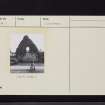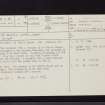Drem, St John's Chapel
Burial Ground (Medieval), Chapel (15th Century)
Site Name Drem, St John's Chapel
Classification Burial Ground (Medieval), Chapel (15th Century)
Alternative Name(s) Drem House; Drem Farm
Canmore ID 56302
Site Number NT57NW 3
NGR NT 50820 79490
Datum OSGB36 - NGR
Permalink http://canmore.org.uk/site/56302
- Council East Lothian
- Parish Athelstaneford
- Former Region Lothian
- Former District East Lothian
- Former County East Lothian
NT57NW 3 50820 79490
(NT 5082 7949) St John's Chapel (NR) (remains of)
OS 6" map (1968)
The probable 15th c remains of St John's Chapel, which belonged to the Knights Templars, are situated in the garden W of Drem House. Formerly measuring 43' E-W by 21', they now consist of only the W gable which contains two windows. A doorway with a semi-circular head is built into the garden wall to the N.
RCAHMS 1924, visited 1913
NT 5082 7949. The remains of St John's Chapel are as described. The doorway is at NT 5082 7950.
Visited by OS (BS) 14 July 1975.
Field Visit (27 May 1913)
In the garden west of Drem house are the ruins of a small chapel ‘called St. John's Chapel, which belonged to the Knights Templars’ (1). The building has measured over walls 43 feet from east to west and 21 feet from north to south. A portion of the east gable can be traced in the garden wall. The west gable, ivy-clad, stands complete (fig. 45 [ELD 36/1]). In it are two windows with sills a (different levels and at a considerable height from the ground. The northern window is a two-light lancet with daylights 7 to 8 inches wide. The mullion is wanting. The southern window is a semicircular headed single light some 3 feet 6 inches wide. These windows have a splay worked on the jamb and appear to be insertions. The lateral walls no longer exist. A doorway with a semicircular head is built into the garden wall to the north. It is 3 feet 1 inch wide and 6 feet 10 inches high. A small splay is worked on the jamb.
The chapel is built of whin and rubble with freestone dressings and was probably erected in the 15th century. The windows and door as above mentioned appear to belong to a later period.
RCAHMS 1924, visited 27 May 1913
(1) Statistical Account vol. x. p. 175.










